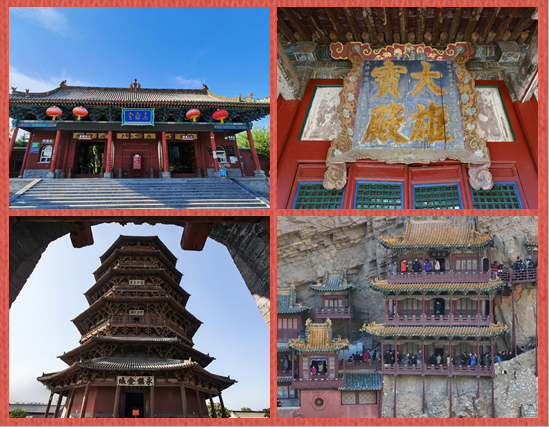Culture heritage bolsters tourism in Shanxi
Updated: 2025-05-19
Province's renowned history, attractions prove a hit with tourists during recent May Day holiday
During the five-day May Day holiday, spanning from May 1 to 5, tourists to the North China province of Shanxi were offered an impressive experience due to the local tourism practices to integrate history and modernity, cultural heritage with natural attractions, and enhanced services for visitors.
On the evening of May 2, after a tight day's schedule touring the ancient city of Datong, Zhang Yifan, a tourist from Beijing, joined a crowd of people gathering in a square in front of Yongtaimen – the southern gate of the city wall. They were waiting for the opening of a performance show entitled Because of Datong.
When the setting sun's glow on the glazed roof tiles of the gate tower became dim, the show began with a big shout: "Open the gate!"
The city gate opened, men and women, wearing clothes of the ancient Xianbei ethnic group, were found dancing on both sides of a flagstone walk leading to the interior of the city wall. Audience members were ushered into a show area featuring a huge stage with rows of seats in front of it.
When seeing the show beginning with craftsmen working on a cliff with chisels and a caravan approaching with the ringing of camel bells, Zhang immediately realized it is about the city's heyday in history and what made it a cultural landmark in Shanxi and even the entire country.
As the show reveals, one and a half millennia ago, Datong was standing at the crossroads of cultural exchanges between the East and West, and among various ethnic peoples inside China.
Datong, then called Pingcheng, used to be the national capital of the Northern Wei Dynasty (386-534), which was founded by the Xianbei ethnic people from China's northeast. Generations of emperors and rulers showed their willingness to integrate with the cultures of other ethnic groups, especially the Han, and to embrace the Buddhist culture coming all the way from the west via the ancient Silk Road.
A shining example of this cultural exchange and integration move was the construction of the Yungang Grottoes, a Buddhist cave art treasure trove carved out of the mountain cliffs in the western suburbs of Datong.
When Datong served as the national capital of Northern Wei, it was also an important hub of the ancient Silk Road. Along with the trade in commodities, Buddhism came via this traditional trade route from its original birthplace in South Asia.
In the process of spreading the Buddhism religion to China, which began during the Eastern Han Dynasty (25-220), the dissemination of Buddhist culture, represented by the construction of caves and temples throughout the country, came to its peak during the period spanning from the fourth to the sixth centuries.
At that time, Mogao in Dunhuang, Gansu province; Yungang in Datong, Shanxi province; and Longmen in Luoyang, Henan province represented the highest level of Buddhist cave art.
In Datong, between the fifth and sixth centuries, local artisans, led by the famed monk Tan Ya, constructed dozens of cliffside caves and hundreds of smaller niches in Yungang. They then decorated the spaces with colored sculptures, patterns and architectural structures. Consequently, Yungang became an enduring legacy of history, culture and art.
After watching the show, Zhang said he had a better understanding about Datong and Yungang Grottoes. "This show, leveraging modern digital technologies and a novel narrative style, presented vivid stories on what makes Yungang a cultural landmark and Datong an enticing tourist attraction," Zhang said.
Integrating tradition with modernity was the theme of many tourist destinations in Shanxi during the May Day holiday.
In the ancient city of Pingyao, which had been the hub for business activities of the renowned Shanxi merchants, a number of events, including intangible cultural heritage-featured parades and digital light shows, were added to the regular reality show Pingyao Revisited during the May Day holiday, giving tourists an immersive experience on what happened in history.
The city of Pingyao in Jinzhong is said to have the best-preserved historical cityscapes in China. It looks much the same as it looked during the Ming (1368-1644) and Qing (1644-1911) dynasties.
That was also the period when the Shanxi merchants, also known as Jinshang merchants, reached their peak of prosperity.
The Jinshang merchants are said to have dominated the foreign trade business in northern China during the two dynasties, and Pingyao was the hub of their operations.
The Jinshang merchants' success in business has left a precious legacy in Pingyao and its neighboring areas, including the grand family courtyards, and the premises of various old firms, like China's earliest banking firms known as piaohao and armed courier businesses called biaoju.
Many tourists attended an intangible cultural heritage-featured parade on May 1. When strolling through the well-protected ancient streets, they were amazed by the number of premises of old Jinshang firms. "I'm sure that Pingyao definitely outnumbered any city in China in this aspect," said one of the tourists at the parade.
During the parade, tourists learned that Pingyao is not only about Jinshang-related legacy, there are also rich forms of intangible cultural heritage.
The representative ICH items in Pingyao include lacquerware and beef made with ancient techniques.
Shopping for lacquerware and beef is always a part of the itinerary for many tourists to the city.
The traditional techniques for Pingyao's hand-polished – or tuiguang – lacquerware made the national ICH list in 2006. Those for beef production were included in the same list in 2008.
Due to its rich portfolio of offerings to tourists, Pingyao received more than 120,000 visits on May 1 alone.
During the May Day holiday, tourists to Shanxi were also offered an opportunity to experience the local life, especially the authentic food of Shanxi.
Chen Donghai, a tourist from the neighboring province of Shaanxi, for instance, spent one day exploring the streets and alleys in the southern Shanxi city of Yuncheng, to find some food varieties favored by both locals and tourists.
He started his journey on the early morning of May 4. During a random stroll, he was lured in by the pleasant smell of food to a neighborhood fair called Donghu Farm Produce Market.
To his surprise, there were many similar-minded tourists who saw an experience of local food as an important part of their itinerary. He was informed by one tourist that this market is already a hit on the internet and a check-in place for many tourists to Yuncheng.
He was amazed by the variety of snacks and fruits displayed at stalls.
"I was recommended to try a local snack called egg-and-jujube cake," Chen said. "This is something I tasted for the first time."
He also tasted other snacks like fried dough twists and persimmon cake, saying that the experience is a highlight of his tour of Shanxi.
In a rural tour destination called Duncun in the city of Xinzhou, the unique experience is visiting a nighttime fair featuring an open-air movie theater surrounded by dozens of dining outlets.
"Watching a show of old movies, complemented with kebabs and beer, is the most relaxing part of our tour in Shanxi," said a tourist.
For many visitors, a tour of Shanxi is always a feast to their taste buds as there are more than 1,000 food varieties made from flour, including the famed knife-cutting noodle and flowery bun.
Shanxi's improved infrastructure and services prove to be another draw to tourists during the May Day holiday.
A solo traveler surnamed Zhang said what prompted him to make the decision to visit Shanxi this time is the easy access to charging facilities along the roads and in scenic areas, because he plans to travel with an electric car.
"I learned that charging stations for electric vehicles are easily available in Shanxi," he said. "But I was still surprised and delighted when I saw free charging services are offered at the parking lots of many scenic areas."
To facilitate travel in Shanxi, the province has built three major sightseeing highways to link thousands of destinations along the Yellow River, the Taihang Mountains and the Great Wall. With a total length of about 13,000 kilometers, the three highways – called Yellow River No 1, Taihang Mountains No 1 and Great Wall No 1 respectively – became fully operational last year.
Upon the full operations, the transport authority of Shanxi immediately released a three-year action plan to improve infrastructure and services of the roads.
This plan's basic requirements for the highways include a service area to be established every 25 km and a charging station every 50 km.
It also calls for the establishment of a great number of camping sites, viewpoints and public toilets, as well as 5G telecommunication base stations along the roads.
In Datong, to meet the demand of the increasing number of tourists, the urban bus service was extended to 10 pm during the May Day holiday. And three shuttle bus lines were added to transport tourists to hot destinations like Yungang Grottoes.
Similar bus lines dedicated to tourist transportation were also added in cities including Xinzhou and Linfen.
During the five-day holiday, Shanxi received more than 22 million domestic tourist visits, increasing 22.4 percent from the same period of last year, according to the Shanxi Provincial Department of Culture and Tourism.
The total revenue generated from domestic tourists reached 16.03 billion yuan ($2.22 billion), growing 27.61 percent year-on-year.
Although province-wide statistics for inbound overseas tourists are not available yet, many individual tourism operators in Shanxi reported steady growth in this aspect.
Some overseas tourists said that the fame of Shanxi as a cultural tourism destination has already been known by many and the province is highly preferred when they make plans to visit China.
An Australian tourist named Emily, for instance, was among the many foreign visitors to Pingyao ancient city.
Emily said she was there to experience the culture relating to the famed Jinshang merchants.
She added that the grandeur of the city, with its well protected ancient streets and old buildings, amazed her, giving her a better understanding of the prosperity of Jinshang merchants in the old days.
Several Serbian tourists were found at the Fantawild Oriental Heritage Taiyuan, an amusement park themed around the culture, history, legends and folk traditions of Shanxi.
"I like the way that Chinese culture is presented in the amusement park, with history revived with modern technologies," said one of the Serbians.
In addition to drawing in tourists from its traditional markets of Europe, the Americas, Australia and Southeast Asia, Shanxi is expected to attract visitors from a new source country – Mongolia – this summer.
On May 2, a group of visitors representing the North Asian country's tourism operators began a business research tour of Datong. They were there to explore the local tourism resources before the opening of the Datong-Ulan Bator flight on June 3.
Zhang Qi contributed to this story.



